It seems like a memory now, but our trip to CES last week was one of the better ones we’ve experienced. The spirit at this conference is always upbeat and forward-looking. But there was something very different about this year’s CES.
Jerry Lee sensed it, too. Of course, he’s been attending CES for nearly five decades, so his perspective is especially valuable. He was exuberant about CES 2015, and 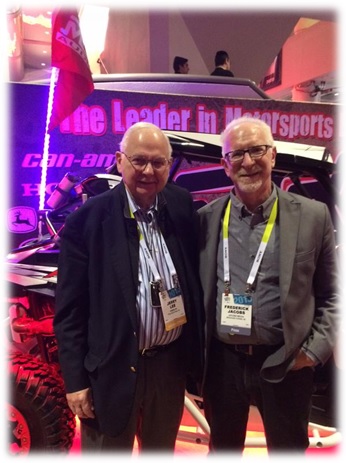 told us:
told us:
“The next 5-10 years for CES will be amazing.”
Jerry may be the most interesting man in radio, from his special Porsche walking shoes to the newest device he discovered that freshens up his shirts. So why is Jerry so bullish about CES today and the next several years for these mega-conferences?
Because “The Internet of Things” felt like “The Internet Of Everything.” At past CES conferences, things seemed siloed. You looked at phones. Then you looked at laptops. Then you looked at TVs. Then you looked at treadmills and ellipticals.
But now everything is connected, and it goes back to smartphones, and specifically, apps. Whether you’re looking at a smartwatch by Martian or a washing machine at LG, there’s a handy smartphone with a specific app that allows the consumers to control her experience.
It’s all becoming connected, whether its cars, fitness equipment, or home security. And smartphones and their apps are really the digital blood that flows through the system, connecting these devices and providing unique, personalized experiences.
That’s why we’ve come to look at Steve Jobs in a very different way over the years. While Apple doesn’t make an appearance at CES – they don’t buy exhibit space – they are everywhere. And if you think of Apple innovation as just iPods, iPhones, Macs, and iPads, you’re missing his greater contributions.
Thousands and thousands of businesses and brands throughout the world utilize the Apple ecosystem, powered by the App Store. In newly released data, Apple claims to have created more than 627,000 U.S. jobs from apps designed for its devices. Last year, consumers spent $10 billion in their App Store.
You may not directly feel the Apple aura when you’re at home or work, but when you’re at CES, Apple, apps, and smartphones in general, are ubiquitous. And obviously, Android has become a mega-watt player in the space as the operating systems are simply mandatory for brands that are building apps. While smartphones themselves didn’t break much ground at CES, they are the connective tissue of thousands of devices, gadgets, and innovations. And there’s no end in sight.
 But at CES, it goes beyond gadgets, and is more about mindset.
But at CES, it goes beyond gadgets, and is more about mindset.
From Ford’s new CEO Mark Fields (left) to small entrepreneurs from overseas, everyone is betting the ranch on risk-taking and innovation. In his keynote, Fields talked about Ford’s “Smart Mobility Plan” and 25 experiments they’re conducting globally to discove new ways of reimagining transportation and the consumer experience to make people’s lives better.
Fields set the tone at Ford that was started by his predecessor, Alan Mulally. Wearing jeans and a sports jacket, he took the room on a guided tour of his company’s outlook about technology and innovation.
And autonomous cars, 3D printing, and drones are part of the CESt buzz. This event is a reminder to all of us about the importance of staying ahead of the game – a challenge that everyone at CES feels every second you’re on the floor.
It’s positively inspiring whether you’re looking at the Gargantuan LG exhibit with the most amazing TVs, refrigerators, and home speaker systems, or the two Asian dudes showing off their ergonomic handheld device that can help you lose weight for $99, or the Orthodox Jewish guys showing off an incredible line of smartwatches. From the biggest companies to bootstrap entrepreneurs, CES represents every type of innovation you can imagine. And it is exhilarating to be in the presence of these creative dreamers.
So what were the highlights at CES15?
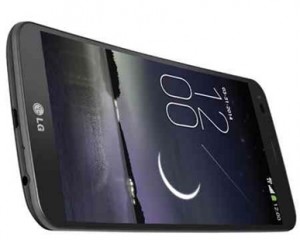 There’s a flight to quality (and style). On the TV side, the screens are curving and there’s lots of talk about 4K, ultra-thin designs, and easier for consumers to be able to navigate and select programs. It is less about the network or source of the content, and more about what program do I want to watch now.
There’s a flight to quality (and style). On the TV side, the screens are curving and there’s lots of talk about 4K, ultra-thin designs, and easier for consumers to be able to navigate and select programs. It is less about the network or source of the content, and more about what program do I want to watch now.
Phones are curving, too, like this nifty model from LG that we demoed on the floor at their super-crowded exhibit.
And on the audio side, style and quality are also making comebacks. We took a nice long look at the new Sony Walkman. It appears that it will retail over $1,000 and is designed as very high-quality player for people who really care about the sound of their audio.
So we asked our Sony rep whether this new version of the Walkman has an FM tuner built in, and he basically told us we were the first to ask that question. This device isn’t for everyone, but it suggests that quality might be a growing consumer priority.
Neil Young was at CES, and made the same pitch for Pono, his high-end quality audio player. It retails for $399. His quote at CES:
“I didn’t listen to music for the last 15 years because I hated the way it sounded and it made me pissed off and I couldn’t enjoy it anymore, I could only hear what was missing.”

Smartwatches are moving fast. But the space is all over the road. This year, most of the new products were on display at the Sands, a good distance away from the Convention Center. And there were a lot of smartwatches on display.
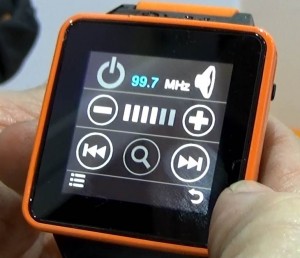 Some brands – like Martian – are back to focusing on the design of their new line. They are beautiful, and have nice functionality – again Bluetooth connected to your smartphone.
Some brands – like Martian – are back to focusing on the design of their new line. They are beautiful, and have nice functionality – again Bluetooth connected to your smartphone.
Others like Kronoz are more functional. They combine the Swiss mindset with a very sharp focus on basic utilities.
And then there was Burg. They have a very cool line of smartwatches that offer many different features, from form to function. We noted a banner listing their smartwatch features that included an FM radio. When we asked to see that particular smartwatch and how it worked, they looked at us like we were aliens. It took them ten minutes to figure out which of their watches featured FM, and it’s pictured at left.
While Burg may not see this smartwatch as an amazing product, I have a few thousand friends in the radio industry who might beg to differ.
At one point, the Burg rep we were speaking to asked me, “What is it with you guys and radio?”
My response? “It’s a long story.”
Obviously, Apple’s entry in the smartwatch space has yet to be released. Who knows why this product has not been announced, but you get the sense that it may be very different than many of the smartwatches we saw. A big question about this space is whether it can become mass market, like mp3 players and tablets. Many consumers are still wondering why they need a smartwatch. It will be interesting to see whether Apple’s foray into this space will change that.
Where’s Radio? And that’s the interesting piece. Radio was pretty hard to find at CES. The automakers are all showing upgraded center stacks. And many were featuring Apple’s Car Play and Google’s Android Auto – frequently in the same vehicles. It looks like the beginning of some degree of standardization.
But no one was talking about the radio. After a nice tour of a well-equipped Volkswagen “center stack” where a guy named Henrich walked me through both the Apple and Google systems, I asked him to show me the radio.
Raised eyebrow from Henrich, like he’s wondering why I want to know about that feature. We turn the radio on, and what do you know, the vehicle has HD Radio. I requested more 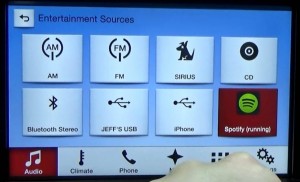 information about his company’s stance on radio and HD Radio, and this very knowledgeable VW guy couldn’t tell me anything about it. Yes, I was the first to ask.
information about his company’s stance on radio and HD Radio, and this very knowledgeable VW guy couldn’t tell me anything about it. Yes, I was the first to ask.
Speaking of cars, Ford unveiled their new Sync3 platform (left), and pretty much everyone you talked to was raving about its improved simplicity and functionality. Ford put a lot of thought into improving their “center stack” approach, and Sync3 appears to be clean, simple, and very easy to navigate.
As you might imagine, the team at jācapps is excited to get their hands on the development kit so they can start modifying radio apps to be compatible with Sync3. Soon, radio station logos will be on new Ford screens, alongside Pandora, iHeartRadio, and Sirius/XM. That’s positively exciting.
NextRadio and HD Radio were well-represented in a nice space in the Central Hall. Paul Brenner gave us a great video walk-through of the new interface, and there was a lot of traffic, questions, and car guys floating around.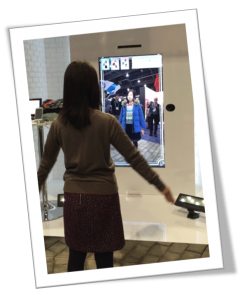
And we actually saw a few of those comforting devices that are still sitting on most of your nightstands. Yes, Timex and Thomson were displaying AM/FM clock radios. And many of the designs of turntables and other devices had a very retro, classic look to them.
Everyone is there (except Apple, Google, and Microsoft). From Gibson Guitars to Polaroid to Nikon to RCA to Timex to the U.S. Postal Service. They all had displays, including some very prominent ones. The Gibson exhibit sat across the street from the Convention Center and was packed. By the way, also in their tent were Onkyo and TEAC. How about that for legacy brands?
Exciting new technologies. Everywhere you go, you bump into some really clever stuff. One that jumped out at me was this virtual “window shopping” technology from Toshiba (right). It’s called the “Virtual Fitting Solution.” A person walking by a store can “try on” outfits and decide whether it’s worth going into the store or buying that cool new jacket online. And they email/text you a photo of how you look with that new outfit. We talked to an engineer through an interpreter, and while it’s not available in the U.S., it will be soon. Just imagine 5th Avenue in New York City or Rodeo Drive in L.A. with this technology.
The crowds. Of course, being the biggest conference in the world has its downsides as Vegas strains to accommodate 160,000+ attendees. Taxi lines that are 30-40 minutes long are the  norm, whether it’s from the airport, or to the Convention Center, or even to casino hotels like the Venetian or the Sands or the Westgate (formerly the Hilton) or the Aria or Wynn/Encore that have all become mega-annexes (“Marketplaces”). Yes, CES outgrew the Las Vegas Convention years ago, forcing more and more exhibits in these satellite spaces that are inconveniently located for convention goers. There’s simply too much to see, and too many people running around trying to see it, making it excessively difficult at times to get from Point A to Point B.
norm, whether it’s from the airport, or to the Convention Center, or even to casino hotels like the Venetian or the Sands or the Westgate (formerly the Hilton) or the Aria or Wynn/Encore that have all become mega-annexes (“Marketplaces”). Yes, CES outgrew the Las Vegas Convention years ago, forcing more and more exhibits in these satellite spaces that are inconveniently located for convention goers. There’s simply too much to see, and too many people running around trying to see it, making it excessively difficult at times to get from Point A to Point B.
It’s no surprise they’re starting CES Asia that will take place later this year in Shanghai, China. While this is a move that obviously follows where the world is headed, it might also alleviate some of the Vegas congestion, which can try your patience (and your feet).
There was so much to see and do that Paul and I each had a video camera, split up, and often went our separate ways in order to capture as much CES as possible. We’re in the process of putting together a video presentation that will take you behind the scenes at CES, and connect the dots about why this conference and so many technologies have direct application to what we’re doing in radio – and what we need to do moving forward. It will take you backstage for conversations with the engineers, the marketers, and the executives at CES with the goal of helping radio understand how the consumer electronics world is rewiring our lives. And changing the radio broadcasting industry.
Don’t think that reading this blog post, or Holland Cooke’s articles, or Perry Michael Simon’s snarky CES tweets just saved you a few thousand bucks. To truly experience this amazing event, you have to be there.
Next year, we’d love to bump into you in a taxi line at CES.
This slide show from MSN will give you an idea of just how amazing CES was this year.
- What To Do If Your Radio Station Goes Through A Midlife Crisis - April 25, 2025
- A 2020 Lesson?It Could All Be Gone In A Flash - April 24, 2025
- How AI Can Give Radio Personalities More…PERSONALITY - April 23, 2025




Good summary. I, too, was at CES. I recommend anyone who touches technology in any way as a part of their job attend this event. The things shown off are great, but talking to the inventors and developers of some of the technology is amazing. They have ideas about personalized experiences that radio (and all content creators) could really learn from.
I’m excited to share some of the possibilities with my team. What a great experience! I plan to return next year. There’s too much to miss by not going.
Thanks for the comment, Rico. CES is one of those experiences where it’s simply difficult to describe it until you’ve been there. There’s a lot there for radio, even though there wasn’t a lot of radio there. Appreciate you taking the time.
REALLY great recap Fred..thanks for taking the time. Fascinating.
I suppose that there’s two posts (now with mine included) speaking to the article likely says a lot about why radio’s influence at a event like this is barely visible
Much appreciated, Dave. We’d really love to see more presence at this very important show.
Thanks Fred! Such a great wrap up of what’s going on this year in consumer electronics. Radio listeners are our consumers and we must remain aware and vigilant to how they are consuming audio and how it’s going to be consumed in the future. I have looked at attending CES the past two years, but now I know I must go. See you there in 2016!
You got a deal. And if you can grab me a cab…
Fred, Thank you for keeping us up to date. I would love to attend sometime, but January is always a busy month for me. Hopefully next year the tagline will be, ” Hey what is it with radio this year?” (in a positive context)
Let’s hope so. Thanks for the kind words, Charlotte.